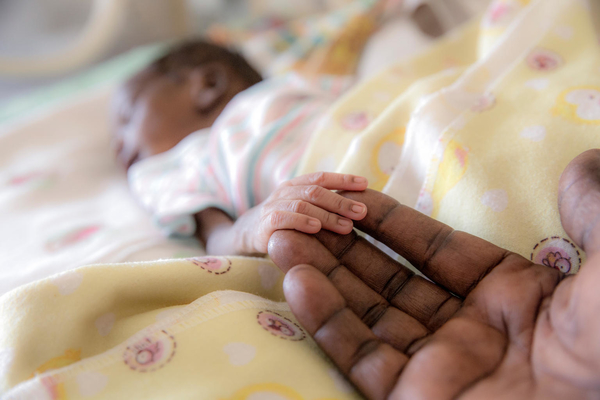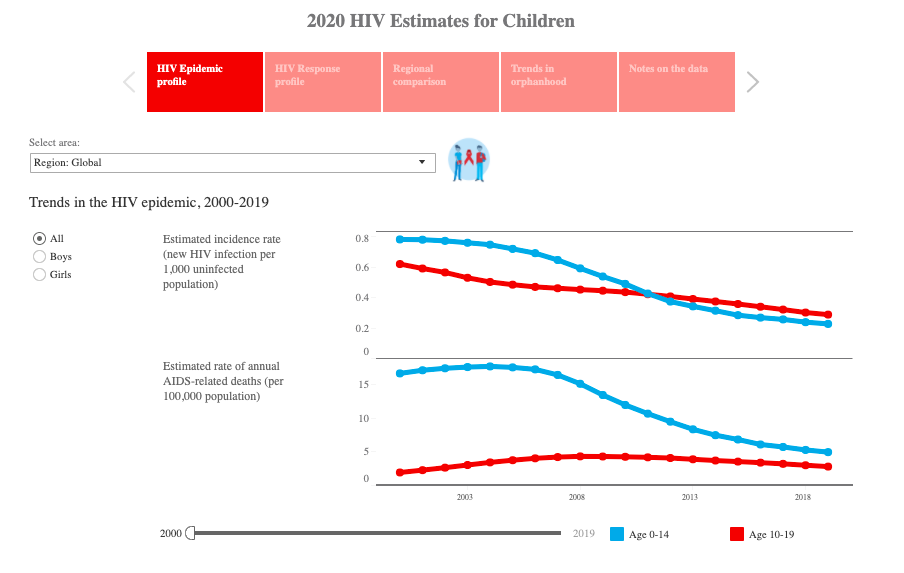Orphanhood
About ten per cent of all orphans globally have lost one or both parents due to an AIDS-related cause
Fast fact:
- Of the 147 million orphans (0–17 years) globally, 14.9 million [confidence bounds: 11.9 million–18.3 million] lost one or both parents due to an AIDS-related cause in 2021.
Protection, care and support for children affected by HIV and AIDS
A growing number of countries are developing national action plans for orphans and other vulnerable children. As of 2021, an estimated 14.9 million [11.9 million–18.3 million] children worldwide had lost one or both parents to due to AIDS-related causes. Three quarters of these children (11.2 million [9.1–13.6 million]) live in sub-Saharan Africa.
Children orphaned due to AIDS make up 10 per cent of all orphans worldwide, but 28 per cent of all orphans are in sub-Saharan Africa. The smallest proportion of orphans due to AIDS-related causes are in Middle East and North Africa (1 per cent).
Risks faced by orphans and other vulnerable children
Orphans and children considered vulnerable for other reasons, including HIV and AIDS, are at higher risk of missing out on schooling, living in households with less food security, and suffering from anxiety and depression. They are also in greater danger of exposure to HIV. Their experiences differ across families, communities and countries, and are influenced by a complex mix of variables, including children’s relationships to their caregivers, the wealth of their households and communities, HIV prevalence in the area and many other factors. To care properly for orphans and vulnerable children, a minimum package of support is needed and includes access to services such as education, health care, social welfare and protection. However, without laws, policies and services that assist families and communities in caring for children at risk, such support tends to remain low.
Developing routine monitoring indicators and tools for collecting data on orphans and vulnerable children is difficult since a standard definition of ‘vulnerability’ has not been established and a minimum package of services has yet to be determined. In addition, poor coordination of services means there is the strong possibility that children will receive multiple services and be counted more than once, skewing the data used to inform programmes. Greater attention needs to be given to defining optimum services and beneficiaries as well as strengthening coordination and reporting on the services provided to orphans and vulnerable children.
Progress: National-level responses
The shift towards inclusive programming to help all vulnerable children, including those directly affected by AIDS, is making an impact. The growing call for a broader, more inclusive definition of vulnerability is reflected in many national action plans. In Zimbabwe, for instance, the National Plan of Action for Orphans and Other Vulnerable Children embraces a broad definition of vulnerability that extends beyond orphanhood and the impact of HIV and AIDS.
National-level responses to orphans and vulnerable children have increasingly become part of broader social welfare and assistance to vulnerable populations, including children, such as social protection programmes that are HIV-sensitive. In sub-Saharan Africa, social protection programmes have been scaled up significantly.
For information on UNICEF’s programme and policy work, visit the Children & AIDS community of practice.
HIV/AIDS data
Build and download your own customisable dataset
Resources


Data sources + methodology
Global AIDS monitoring 2022
In order to monitor the HIV response and progress towards achieving global goals, countries submit national and subnational data on a host of indicators to the Global AIDS Monitoring (GAM) system. Annual submissions are reviewed and validated. Data consist of programmatic data for HIV prevention, testing and treatment. Other indicators require data from population-based surveys and surveys focused on key populations at risk of HIV infection.
For more information, click here.
UNAIDS Estimates and Spectrum’s AIDS Impact Model
Each year countries update their AIDS Impact Model in Avenir Health’s Spectrum software to develop the latest estimates for the HIV epidemic. Supported by UNAIDS, WHO and UNICEF these estimates are used to inform programme and policy decisions for HIV epidemic response.
Useful links:
Methods for HIV modelling are developed by the UNAIDS Reference Group on Estimates, Modelling and Projections.
All available data on HIV estimates are available at aidsinfo.unaids.org.
Nationally representative surveys
Multiple Indicator Cluster Surveys (MICS), Demographic and Health Surveys (DHS), AIDS Indicator Surveys (AIS), Population-based HIV Impact Assessments (PHIA) reproductive health surveys, sexual behaviour surveys and other nationally representative surveys are currently used to collect data on HIV and AIDS.